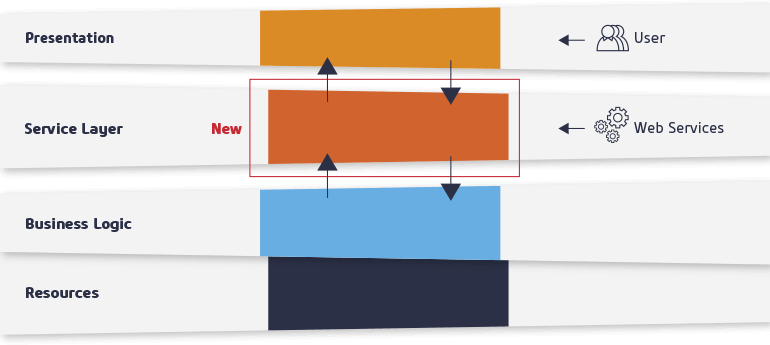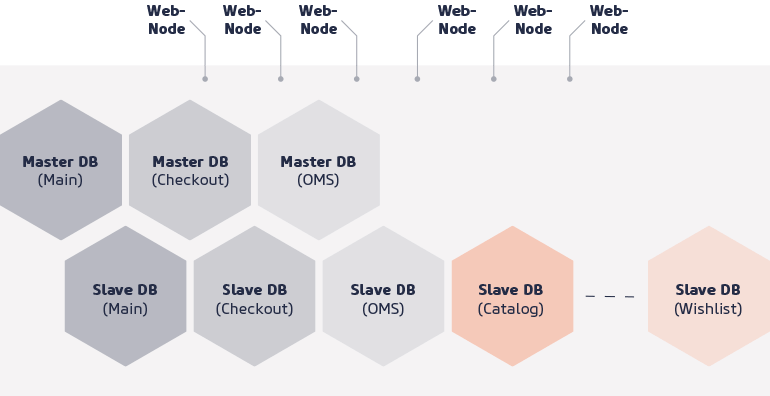The Basis For Successful eCommerce
Magento
Magento’s cutting-edge technologies, outstanding flexibility, huge developer community, and hundreds of partners have solidified its standing as one of the world’s leading e-commerce platforms.

B2B
More flexibility for retail
Adobe Commerce
Take your store system to the next level
The Architecture of Adobe Commerce
Maximum flexibility and stability
Overview
Magento The result of many years of further development
Magento has evolved continuously since its debut in 2008. Along this journey, one of the major milestones was its transition to Magento 2, which included the implementation of an entirely new software architecture. The eCommerce solution now focuses more closely on enterprise commerce and B2B business.
Magento was traditionally offered in two versions: the free Open Source edition (formerly called the Community Edition) and the more comprehensive Enterprise Edition, now called Magento Commerce and particularly suited for B2B applications. Magento Commerce and Magento Open Source both incorporate the latest version of Magento, and all versions are collectively referred to as Magento in everyday language.
Magento facts & figures
Magento’s unique feature set has contributed to its widespread use and global popularity. This is confirmed by a study by Cologne-based EHI Retail Institute, identifying Magento as the eCommerce solution most commonly installed among the 1,000 largest German online stores.
Magento, including its Magento 2 version, is one of the leading eCommerce systems in Germany and worldwide. This is backed up by two studies: US market analyst Gartner has ranked Magento as a “Leader” in the “Magic Quadrant for Digital Commerce,” and Forrester describes Magento Commerce 2 as the best solution for mid-market B2B organizations.
12,957
Magento-based online stores worldwide
5
percent global market share
Central elements of Magento
Magento has always been recognized for its flexibility and cost-effective operation, making it highly attractive to a broad spectrum of companies with manifold business models. Its open architecture, exemplified by its open source/open core solution and REST APIs, has fostered the development of diverse solutions through an extensive partner network. Magento will continue to evolve as an eCommerce solution under Adobe’s stewardship, enhancing its appeal for numerous applications in the future.
The Magento portfolio consists of several key components including:
- Magento B2B: Dedicated modules designed for business-to-business applications, addressing the specific needs of this sector.
- Magento Order Management: A multichannel feature that enables companies to manage customer needs efficiently across different channels.
- Magento Business Intelligence: A user-friendly, scalable data warehouse solution designed to process large data volumes.
- Magento Page Builder: A content management system that simplifies integrating content such as text, images, and videos into online stores.
- Magento Shipping: Facilitates seamless integration of fulfillment and logistics service providers to optimize shipping processes.

Special application areas of Magento
High-revenue B2C/B2B eCommerce platforms
Magento is renowned for its outstanding flexibility, ensuring the efficient realization, operation, and management of elaborate, large-scale projects and complex challenges in the B2C/B2B domains.
Scalable eCommerce platforms
Magento’s user-friendly scalability allows online stores and e-commerce platforms to grow seamlessly to reflect the success and growing needs of their operators.
eCommerce projects with an international focus
Magento’s flexibility and scalability are most prominent in international operations where its multilingual and multi-currency support make it the ideal solution for global e-commerce projects.
Multishop support
Companies operating multiple brands and/or web presences can manage each of their online stores centrally via the Magento platform.
The company
behind Magento
Adobe acquired Magento in 2018 with the clear goal of integrating a top-tier partner to secure itself a leading place in the eCommerce market. By merging the two product ecosystems, Adobe can now offer customers an extensive, end-to-end service suite. Please visit the official websites for more information about Adobe and its product portfolio.
Technology
Magento Innovative architecture
Magento is a flexible, cutting-edge enterprise e-commerce framework which contrasts sharply with many of its competitors’ rigid, online store monoliths. Its multi-layered architecture and extensible service layer center on an advanced software concept which lets e-commerce platforms be tailored to individual needs without sacrificing fast time-to-market. Its extensive modularization makes Magento one of the most flexible and adaptable e-commerce solutions available.

Strengths of the service layer
The service layer connects the front end – or presentation layer – with the platform’s backend which contains the entire business logic.
It serves as a developer interface for integrating custom requirements for various front ends with the underlying business logic. This is practical, for example, when an application’s mobile and standard PC versions have different front-ends but both access the same business logic; another example might be a web store which contains various custom marketing landing pages with bespoke content that accesses a generic, integrated checkout process for direct conversions.
The service layer incorporates a stable API enabling efficient integration with other systems using REST or SOAP services. This means that store operators wishing to use SAP, for example, can do so via the API interface.

Outstanding scalability
A key feature of Magento and Adobe Commerce is the outstanding scalability of the database structure which allows partitioning of database masters for different genres of data – such as checkout and catalog information. This partitioning significantly enhances performance and allows seamless scaling across international infrastructures.
Ask our experts!
Just give us a call.





